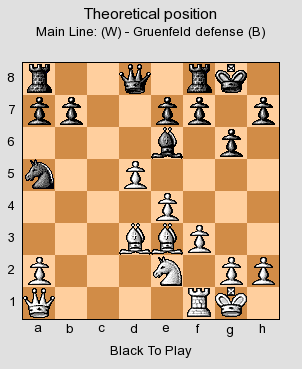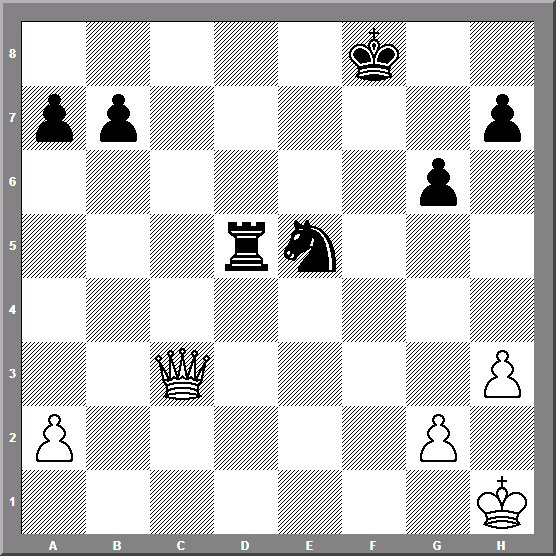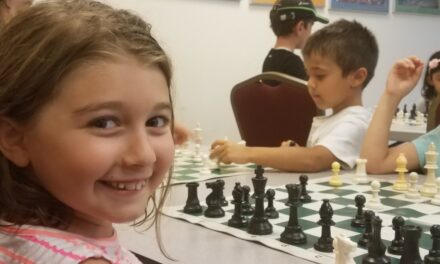This was one of the most theoretical games of the tournament. It showcases deep knowledge of the Gruenfeld Defense theory and can be enjoyable for both beginners and Masters.
(1) Gurczak,John (2059) – Lebovitz,Andrew (2050) [D89]
Tucson Open, 24.01.2010
[Gurczak,John]
1.d4 Nf6 2.c4 g6 3.Nc3 d5 4.cxd5 Nxd5 5.e4 Nxc3 6.bxc3 Bg7 7.Bc4 c5 8.Ne2 Nc6 9.Be3 0–0 10.0–0 Bg4 11.f3 Na5 12.Bd3 [Another option is 12.Bxf7+ Rxf7 13.fxg4 Rxf1+ 14.Kxf1 Qd6] 12…cxd4 13.cxd4 Be6 14.d5 Bxa1 15.Qxa1 f6 16.Qd4 [16.Bh6 Re8 17.Kh1 Rc8 (17…Bd7) 18.Nf4 Bd7 19.e5 Nc4 20.e6 And black can play either Ba4 or Bb5.; 16.Rb1 is an old line that has died out. The last time this line was played was back in 2005. Black seems to score well and white does not get as much play for the exchange as in the 16. Qd4 and 16. Bh6 variations. 16…Bd7 17.Bh6 Rf7 18.e5 fxe5 19.Qxe5 Rc8 (Not 19…Qb8? 20.Qxb8+ Rxb8 21.Bd2 Trapping the knight) ] 16…Bf7 [16…Bd7 17.e5 A typical break in the center. 17…fxe5 18.Qxe5 Qb8 19.Qxe7 Re8 20.Qc5 b6 21.Qc1 White tends to score well in these variations.] 17.Bh6 Re8 18.Bb5 e5 [18…Qb6 19.Qxb6 axb6 20.Bxe8 Bxe8 21.Rc1±] 19.Qf2 Re7 20.f4 exf4 [20…Rc8 21.fxe5 Rxe5 22.Ng3 Nc4 (22…Qb6 23.Qxb6 axb6 24.Rxf6±) 23.Qxf6 Qxf6 24.Rxf6²; 20…Qb6 21.Qxb6 axb6 22.fxe5 Rxe5 23.Ng3 Be8 (23…f5 24.Bf4 Re7 25.d6±) 24.Bd3 f5 25.Bf4 fxe4 26.Nxe4 Rf5 (26…Re7? 27.Nf6+ Kf7 28.Bd6) 27.g4 Rf7 28.g5²] 21.Qxf4 Bxd5?! [21…Qb6+ 22.Kh1 Bxd5 Was more accurate.] 22.exd5 Qb6+ 23.Kh1 I was not completely sure of 23. Nd4 so I decided to play what I knew. [23.Nd4! a6 (23…Rd8 24.Qxf6 Qxf6 25.Rxf6 Rf7 26.Re6+-) 24.Ba4 f5±] 23…Qxb5 24.Qxf6 Qe8 25.Qd4
f6 16.Qd4 [16.Bh6 Re8 17.Kh1 Rc8 (17…Bd7) 18.Nf4 Bd7 19.e5 Nc4 20.e6 And black can play either Ba4 or Bb5.; 16.Rb1 is an old line that has died out. The last time this line was played was back in 2005. Black seems to score well and white does not get as much play for the exchange as in the 16. Qd4 and 16. Bh6 variations. 16…Bd7 17.Bh6 Rf7 18.e5 fxe5 19.Qxe5 Rc8 (Not 19…Qb8? 20.Qxb8+ Rxb8 21.Bd2 Trapping the knight) ] 16…Bf7 [16…Bd7 17.e5 A typical break in the center. 17…fxe5 18.Qxe5 Qb8 19.Qxe7 Re8 20.Qc5 b6 21.Qc1 White tends to score well in these variations.] 17.Bh6 Re8 18.Bb5 e5 [18…Qb6 19.Qxb6 axb6 20.Bxe8 Bxe8 21.Rc1±] 19.Qf2 Re7 20.f4 exf4 [20…Rc8 21.fxe5 Rxe5 22.Ng3 Nc4 (22…Qb6 23.Qxb6 axb6 24.Rxf6±) 23.Qxf6 Qxf6 24.Rxf6²; 20…Qb6 21.Qxb6 axb6 22.fxe5 Rxe5 23.Ng3 Be8 (23…f5 24.Bf4 Re7 25.d6±) 24.Bd3 f5 25.Bf4 fxe4 26.Nxe4 Rf5 (26…Re7? 27.Nf6+ Kf7 28.Bd6) 27.g4 Rf7 28.g5²] 21.Qxf4 Bxd5?! [21…Qb6+ 22.Kh1 Bxd5 Was more accurate.] 22.exd5 Qb6+ 23.Kh1 I was not completely sure of 23. Nd4 so I decided to play what I knew. [23.Nd4! a6 (23…Rd8 24.Qxf6 Qxf6 25.Rxf6 Rf7 26.Re6+-) 24.Ba4 f5±] 23…Qxb5 24.Qxf6 Qe8 25.Qd4 Rd8 [25…Rc8 26.Ng3 Rf7 27.Rxf7 Qxf7 28.h3( Rg3e4,Re4f6); 25…Rf7 26.Rxf7 Qxf7 27.Bd2 Qg7 28.Qe4 Qf7 29.Bc3 Rc8 30.h3 Nc4 31.Qd4 Kf8 32.Qh8+ Qg8 33.Qd4 Qf7 34.Qh8+ Was played by Aronian – Shirov WCh Candidates Final, Elista Russia 2007 1/2 – 1/2] 26.Ng3?! [26.h3!] 26…Nc6 [26…Rf7 27.Rxf7 Qxf7(Rd8-d5) 27.Qc3 Ne5 28.Ne4 Rf7 [28…Ng4 29.h3] 29.Nf6+
Rd8 [25…Rc8 26.Ng3 Rf7 27.Rxf7 Qxf7 28.h3( Rg3e4,Re4f6); 25…Rf7 26.Rxf7 Qxf7 27.Bd2 Qg7 28.Qe4 Qf7 29.Bc3 Rc8 30.h3 Nc4 31.Qd4 Kf8 32.Qh8+ Qg8 33.Qd4 Qf7 34.Qh8+ Was played by Aronian – Shirov WCh Candidates Final, Elista Russia 2007 1/2 – 1/2] 26.Ng3?! [26.h3!] 26…Nc6 [26…Rf7 27.Rxf7 Qxf7(Rd8-d5) 27.Qc3 Ne5 28.Ne4 Rf7 [28…Ng4 29.h3] 29.Nf6+ Rxf6™ [29…Kh8?? 30.Bf4 Rxf6 31.Bxe5+-] 30.Rxf6 Rxd5 31.h3 Qe7 32.Rf8+ Qxf8 33.Bxf8 Kxf8
Rxf6™ [29…Kh8?? 30.Bf4 Rxf6 31.Bxe5+-] 30.Rxf6 Rxd5 31.h3 Qe7 32.Rf8+ Qxf8 33.Bxf8 Kxf8 Now it is just a matter of technique for white. The rook and knight are very uncoordinated in this ending and would be tough to hold. 34.Qa3+ [34.Qc7! Was probably more accurate putting more pressure on black.] 34…Kg7 [34…Kf7 35.Qxa7±] 35.Qe7+ Kh6 [35…Nf7 36.Qxb7 Ra5 37.a3±] 36.Qxb7 Rd7 37.Qb5 Re7 38.Qc5 My opponent resigned in view of losing the a-pawn and having no way of stopping my own pawn from queening. 1–0
Now it is just a matter of technique for white. The rook and knight are very uncoordinated in this ending and would be tough to hold. 34.Qa3+ [34.Qc7! Was probably more accurate putting more pressure on black.] 34…Kg7 [34…Kf7 35.Qxa7±] 35.Qe7+ Kh6 [35…Nf7 36.Qxb7 Ra5 37.a3±] 36.Qxb7 Rd7 37.Qb5 Re7 38.Qc5 My opponent resigned in view of losing the a-pawn and having no way of stopping my own pawn from queening. 1–0




